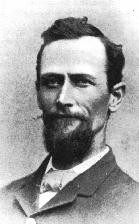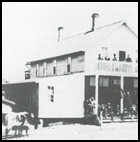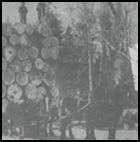
Randolph Lafayette Frazee, for whom the city of Frazee was named after, was born in Hamden Ohio on July 3, 1841. He was the son of Ephraim and Margaret Petty Frazee, who were also natives of Ohio. The name apparently originated at Fraisse, France. Siblings of Randolph were Eliza, 1833, Clinton-1836 and Theodore-1848. Clinton's son, Frank, born in 1859 in Ohio, came to Frazee and worked for R L Frazee as a bookkeeper. He died December 2, 1882 at the age of 23, and is buried in the Chilton cemetery. He was single.
On July 31, 1864, R L Frazee was married to Mary J Brandt at Hamden Ohio in Vinton County. She was born in 1843 in Essen Germany. Their son, Charles Randolph was born in Ohio on May 21,1865. The family came to Minnesota in 1866 and lived at St. Cloud where R L Frazee owned a small sawmill operated by Joseph Sartell. Their daughter Mary (May) was born in 1868. She became the wife of F J McArdle. Wm Edgar was born in New York Mills on October 1, 1870. Henry (Harry E) was born on January 18, 1873. Paul Clifford was born in Frazee, April 13, 1875. Cora Estella was born on May 19, 1879 in Pelican Rapids. She became the wife of Dr. A L Mark.
Randolph L Frazee died at his home in Pelican Rapids on June 4, 1906 from a heart disease. His wife, Mary Jo Frazee, died on January 2, 1923 in St. Paul. Their graves are in the Lakeview Cemetery at Pelican Rapids.

Frazee has had an interesting and colorful history, which dates back a few years before the actual incorporation. Originally named Detroit, the plat of the old town site was made on May 27, 1857. The following was recorded at St. Cloud on June 17, 1857, eleven years before there was a settler in the area that is now Becker County:
"Commencing at an oak tree at the southwest corner of said town site, and running north, crossing the Otter Tail River and Detroit Lake, 5,280 feet, thence running east, crossing the Otter Tail River, 2,058 feet, thence running south 5,280 feet, thence west 2,958 feet to the place of the beginning." The town site was a mile long north and south and over a half mile wide from east to west. The town site contained about 358 ½ acres of land and showed 131 city blocks. The western line was about where the bridge crosses Town Lake (near the Lion's Park and the "World's Largest Turkey") and the eastern line was near the railroad bridge.
Becker County was established in 1858, but not formally organized until February 25, 1871. Detroit village was organized on July 5, 1871. Detroit village was later called Third Crossing and finally named Frazee.
For nearly three years before the Northern Pacific Railroad was built, the nearest station was at Hobart, a long mile on the other side of the Otter Tail River. In the summer of 1872 a company consisting of Absalom Campbell, Charles M. Campbell, Wm. G. Chilton, and T. W. Chilton built a dam and sawmill on Section 26, near where the Nichols, Chisholm Lumber Company's sawmill stood. After operating their mill for a few months, they sold the land to R. L. Frazee, from whom Frazee derives its name. Shortly after Frazee bought this land, he added to it and set about laying out the town site. W. C Darling made the survey of this town site in the summer of 1873. Frazee next began negotiations with the railroad to move the depot a big mile up the track to his town site, and as an inducement he offered one-half lots in his new town site. The move was gradually accomplished, but not before a temporary depot was erected. Finally, on the 25th of October 1874, the depot was loaded on two flat cars, brought across the river, and dumped off at the new station on the north side of the track.
The Honorary Randolph L. Frazee, born July 3. 1841 in Ohio came to Minnesota in 1866. In1868 he moved from St. Cloud to Otter Tail City, and built a sawmill in 1872 where New York Mills is now. This was first called Frazee's Mills. In the fall of 1872, he bought the Campbell-Chilton mill at Frazee, and a year later had added a flourmill in northern Minnesota. These mills burned October 14, 1889.
Mr. Frazee sold all his mill property in 1890 to A. H. Wilcox, who repaired the dam, rebuilding the sawmill on the old foundation the same year, and operating it until January 1897, when he sold to the Commonwealth Lumber Company.
The Village of Frazee started on its way to incorporating on the 6th of January 1891.
By April 15, 1898, The Frazee Village Council had contracted with the Commonwealth Lumber Co. for a number of streetlights to be used on Front and Mill streets. There were 10 poles and on each there would be three large incandescent lights. Seven of the poles would be on Front Street. There were to be three poles on Mill Street, and the remainder of the town would be lighted as before, with oil. Lights also were to be furnished in residences and businesses at $1.00 per month for each light.
The first sewers were begun in1898 and this was quite a step in really being citified!
By 1908 the town was divided into four section: The town proper, The Bunker Hill district, the river district and what they called the church district or church hill on the south side of the railroad tracks.
The Nichols-Chisholm Mill was certainly the biggest industry in town, and one of the largest mills in the state. The village also boasted of a gristmill, a bank, a number of progressive merchants, restaurants, hotels, confectionaries, a newspaper, a high school, and four churches by 1908.

For nearly three years after the Northern Pacific Railroad was built, the nearest station was at Hobert, a long mile on the other side by the Otter Tail River.
In the summer of 1872 a company consisting of Absalom Campbell, Charles M. Campbell, William G. Chilton and T. W. Chilton built a dam and sawmill on Section 26, near where the Nichols, Chisholm Lumber Company's sawmill is now located. After operating their mill for a few months, they sold the property to R. L. Frazee. As soon as Frazee had secured this valuable mill site he made a purchase of all the land on Section 35, lying west and north of the river, and proceeded to lay out a townsite on the north side of the railroad, including a part of Sections 26 and 35. The survey of this townsite was made in the summer of 1873 by W. C. Darling, He next began to negotiate with the railroad company for the removal of the depot from Hobart, and as an inducement in that direction, he gave them half the lots in his new townsite. The removal was gradually accomplished, the depot building not being brought over until some time after a temporary station had been established at the new townsite. Finally, on the 25th day of October, 1874, the depot building was loaded on two flat cars and brought across the river and dumped off at the new station on the north side of the track.
Thomas Murphy, now of Sanborn, North Dakota, claims the honor of being in charge of the removal. In the spring of 1873 Mr. Frazee enlarged the Chilton sawmill and in the fall of the same year built a flour mill adjoining his sawmill, and both mills did a flourishing business for many year. In the spring of 1874 an ugly hole was cut in his mill dam by the high water in the river and it was with considerable difficulty that it was finally repaired. A lot of his saw-logs floated off down the river and were sold to parties below.
In 1881 he built the big, new dam at the east end of Front Street and moved both mills down to the new dam that same fall. The flour mill, however, was considerably enlarged and when completed was the finest flour mill in northern Minnesota. These mills both burned down on the 14th day of October, 1889. The cost of these mills, dam included, was about $60,000, and were insured for $15,000.
In the spring of 1890 he sold all his mill property to A. H. Wilcox, who repaired the dam and rebuilt the sawmill on the old foundations that same year. He carried on the manufacture of lumber until January, 1897, when he sold out to the Commonwealth Lumber Company, who built a new steam sawmill on an extensive scale near where the Campbell mill was built in 1872. This mill, however, is outside the village but close up to the line.
The first house in the village of Frazee was built by James G. Chilton on the rear of what are now lots 11 and 12, block 14, where Chris. Johnson had a laundry a few years ago. This house was built in the summer of 1872 of lumber sawed at the Campbell sawmill.
In the fall of 1873 S. M. Thompkins came down from Oak Lake and built what is now known as the Frazee Hotel or Briggs' House. This hotel was opened up for business about the first of December, 1873. The next October Luther Weymouth moved his hotel over form Hobert and set it up on the south side of the railroad a little east of where the passenger depot now stands. Some of the passenger trains stopped regularly at the Weymouth House for meals. Mrs. Weymouth was a very popular landlady in those days. Her meals were the subject of much flattering comment far and wide. The box-elder and the willow trees growing there at the present time were planted in the rear of the new hotel by Mrs. Weymouth herself. This new hotel hurt the business of the Thompkins' house to a serious extent. As an inducement to draw railroad passengers to his house Thompkins built a broad, high walk from he depot in a straight line to his hotel, over the big hole where Baer's block and the Windsor Hotel now stand. One of the first buildings erected -- as I remember, was the one now owned by Dr. S. S. Jones and used by him as a drug store. It was built by a little Jew whose name I have forgotten, in 1873, for a dry goods store.
The Gummer flour mill was brought up from New York Mills on the 9th of August, 1898, and rebuilt at the lower dam, where it did service until the 3rd of June, 1903, when it was totally wrecked by the washing away of the west end of the dam.
In the summer of 1904 the Stelzner flour mill was built by Mr. C. J. Stelzner, who soon afterwards sold a half interest to James Scott. Leonard Ashley was the first station agent at Frazee.
In the fall of the year 1898 the railroad company moved the passenger depot from the north side of the track, in the rear of Baer's brick block, to the south side near where it now stands, and since that time have used the old side track on the south side of the main line of the railroad for the main line. The building was moved by Charles Wagner, of Detroit.
It should ever be born in mind, however, that much of the real estate in Frazee is bounded, and the descriptions start from the center of the main line of the railroad, and that the original main line is the third track north from the passenger depot since the double track was laid, or the track that runs next to the freight depot, being the most northerly of the three tracks between the two depots.
Incorporation of the Village of Frazee.
On the sixth day of January, 1891, the board of county commissioners of Becker county adopted the following resolution:
Resolved; on receiving and reading the petition of A. H. Wilcox and thirty-four others, residents upon the lands and premises, may vote for or against the incorporation of said premises, and said petition being in due form, it is further resolved, that the electors, resident on said premises shall meet at the Briggs Hotel on said premises on the 10th day of February, A. D. 1891, at 10 o'clock, a.m., and that Edward Gummer, George Combs, and W. Baer are hereby appointed to act as inspectors at said meeting, and that copies of said petition and notices of said meeting be posted as provided by law.
The proposition to incorporate the village received nearly a unanimous vote and the first election of officers was held at Baer's store on the 10th of March, 1891, when the following officers were elected: President, A. H. Wilcox; trustees, William Baer, Clement Mayer and Robert Alexander; village recorder, John Briggs; treasurer, John S. Comstock; justices of the peace, John Neuner and Lewis D. Hendry; constables, John D. Clary and Arnold Kohnen.
The incorporation took in the following territory: The south half of the southwest quarter of Section 26 and all of Section 35, Township 138, Range 40, except the south tier of forties and the west tier of forties.
 See the 1926 Census for the City of Frazee, Minnesota.
See the 1926 Census for the City of Frazee, Minnesota.